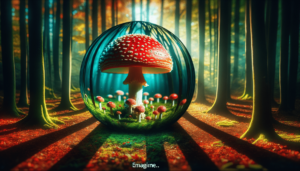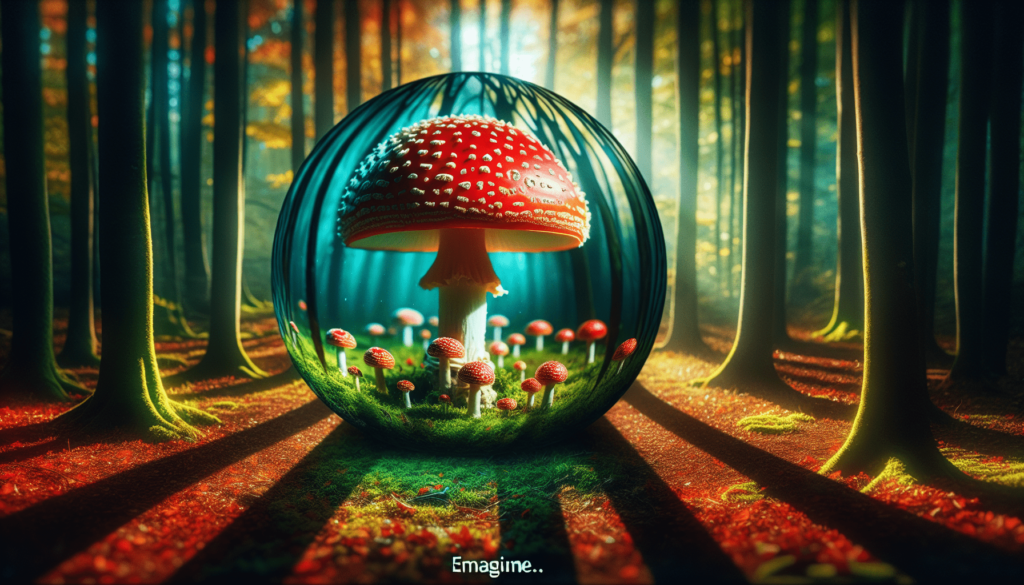Imagine stumbling upon a fascinating mushroom that seems like it comes straight out of a fairy tale. With its vibrant red cap speckled with white spots, the Amanita Muscaria is an enchanting specimen that has captured the curiosity of individuals for centuries. Known for its mystical properties and rich symbolism in various cultures worldwide, this captivating mushroom has become a subject of intrigue and fascination among nature enthusiasts and spiritual seekers alike. In this article, we will explore the intriguing world of the Amanita Muscaria, uncovering its history, cultural significance, and the various legends that have woven their way around this mesmerizing fungus. So, prepare to embark on a captivating journey into the world of the mystical mushroom, the Amanita Muscaria.

Introduction
Welcome to the world of Amanita Muscaria, a mystical mushroom that has captured the curiosity of humans for centuries. In this comprehensive article, we will explore the habitat, physical characteristics, and historical significance of Amanita Muscaria. We will also delve into its cultural and mythological importance, including its symbolism in folklore and its association with shamanism. Furthermore, we will examine the psychoactive properties of this mushroom, its potential dangers and precautions, legal status, cultivation and harvesting techniques, cooking and consumption methods, and ongoing scientific research. By the end of this article, you will have a deeper understanding of the captivating world of Amanita Muscaria.
Overview of Amanita Muscaria
Habitat and Distribution
Amanita Muscaria, also known as the Fly Agaric, can be found in various habitats across the globe. It is most commonly found in northern temperate regions, particularly in coniferous and deciduous forests. These enchanting mushrooms have an affinity for birch, pine, and spruce trees. They thrive in symbiotic relationships with these trees, forming mycorrhizal associations. In addition to their presence in the wild, Amanita Muscaria can also be cultivated in controlled environments.
Physical Characteristics
Recognizable for its striking appearance, Amanita Muscaria has distinct physical characteristics that make it easily identifiable. It typically has a bright red cap speckled with white or yellowish warts. As the mushroom matures, the cap expands, revealing its characteristic white gills beneath. The stem is usually white or yellow, and it is adorned with a delicate white ring. It is important to note that the coloration of Amanita Muscaria can vary, and there are also yellow and orange variations of this mushroom.
Historical Significance
Throughout history, Amanita Muscaria has held a special place in various cultures and civilizations. It has been depicted in ancient rock art, cave paintings, and manuscripts, showcasing its importance in human history. The use of Amanita Muscaria in religious rituals, traditional medicine, and cultural ceremonies can be traced back thousands of years. Its historical significance and enduring presence in different societies make it a fascinating subject of study and exploration.
Cultural and Mythological Significance
Symbolism in Folklore and Fairy Tales
Amanita Muscaria has long been associated with folklore and fairy tales, captivating the imaginations of storytellers and dreamers alike. In many cultures, this mushroom is seen as a symbol of luck, transformation, and enchantment. It is often depicted as a magical ingredient that grants wishes, brings fortune, or leads to extraordinary adventures. The distinct red and white appearance of Amanita Muscaria has inspired numerous tales and visual representations, making it an iconic symbol in the realm of folklore.
Association with Shamanism
Shamanism, a spiritual and healing practice, has a profound connection with Amanita Muscaria. It is believed that the consumption of this mushroom played a vital role in the rituals and journeys undertaken by shamans in certain cultures. The psychoactive properties of Amanita Muscaria were thought to facilitate altered states of consciousness, allowing shamans to communicate with the spirit realm, gain profound insights, and heal individuals. This association between Amanita Muscaria and shamanism highlights the sacred nature of this mushroom in ancient traditions.
Amanita Muscaria in Popular Culture
Amanita Muscaria’s allure extends beyond ancient practices and folklore. It has found its way into popular culture, influencing literature, art, and entertainment. From Lewis Carroll’s “Alice’s Adventures in Wonderland” to various art movements, Amanita Muscaria has made its mark in the creative world. It continues to be a symbol of mysticism, fantasy, and alternate realities, captivating the imaginations of both artists and enthusiasts alike.
Psychoactive Properties
Chemical Composition
Amanita Muscaria contains various compounds that contribute to its unique psychoactive properties. The most notable of these is muscimol, which acts as the primary active ingredient. Muscimol is a GABA receptor agonist, meaning it binds to and activates specific receptors in the brain. Additionally, ibotenic acid is present in Amanita Muscaria, but it is converted into muscimol when the mushroom is dried or heated.
Effects on the Human Brain
When consumed, Amanita Muscaria can induce a range of effects on the human brain. These effects can vary depending on factors such as dosage, individual sensitivity, and preparation methods. Common experiences include feelings of euphoria, altered perception of time and space, enhanced creativity, and spiritual insights. However, it is important to note that the effects of Amanita Muscaria can also be unpredictable and potentially unpleasant for some individuals.
Traditional and Modern Uses
Amanita Muscaria has been used traditionally for spiritual and medicinal purposes. It was believed to facilitate communication with the divine, aid in divination, and provide relief from various ailments. In modern times, the use of Amanita Muscaria as a recreational hallucinogen has gained popularity, leading to its inclusion in the psychonautic culture. It is important to approach the consumption of Amanita Muscaria with caution and respect, as its psychoactive properties can have profound effects on the mind and body.

Dangers and Precautions
Toxicity of Amanita Muscaria
While Amanita Muscaria is not considered deadly, it is known to be toxic, and caution should be exercised when consuming or handling this mushroom. The main toxins present in Amanita Muscaria are ibotenic acid and muscazone. These toxins can cause a range of adverse effects, including gastrointestinal distress, muscle weakness, sweating, dizziness, and delirium. In rare cases, severe poisoning can occur, leading to potentially life-threatening conditions.
Potential Risks and Side Effects
Consuming Amanita Muscaria presents certain risks and side effects. These can vary depending on individual sensitivity, dosage, and preparation methods. Common side effects include nausea, vomiting, increased heart rate, drowsiness, and confusion. It is essential to approach the consumption of Amanita Muscaria responsibly and seek medical advice if any concerning symptoms arise.
Proper Precautions and Considerations
To minimize the risks associated with Amanita Muscaria, it is crucial to take proper precautions. These include accurately identifying the mushroom, preparing it correctly, and consuming it in a controlled and safe environment. It is recommended to consult experienced mushroom enthusiasts or mycologists for guidance and adhere to responsible practices. Additionally, it is essential to be aware of any potential interactions with medications or pre-existing medical conditions before consuming Amanita Muscaria.
Legal Status
The legal status of Amanita Muscaria varies across different jurisdictions. In some countries, it is legal to possess and cultivate this mushroom for personal use or cultural practices. However, its use for recreational purposes may be subject to legal restrictions. It is crucial to familiarize yourself with the specific laws and regulations governing the possession, cultivation, sale, and consumption of Amanita Muscaria in your region.

Cultivation and Harvesting
Growing Conditions
For those interested in cultivating Amanita Muscaria, understanding its ideal growing conditions is essential. This mushroom thrives in cool and humid environments, making it suited for regions with temperate climates. It has a mycorrhizal relationship with certain tree species, particularly birch, pine, and spruce trees. Cultivation involves recreating these conditions and providing the appropriate substrate for the mushroom to grow and flourish.
Harvesting Techniques
When it comes to harvesting Amanita Muscaria, caution must be exercised. Harvesting mature mushrooms that have fully expanded caps is key. Care should be taken to avoid damaging the surrounding environment and ensuring the sustainability of the ecosystem. It is important to remember that wild mushrooms can be difficult to identify accurately, and it is advisable to seek guidance from knowledgeable individuals or experts to ensure safe harvesting practices.
Cooking and Consumption
Traditional Methods of Preparation
Amanita Muscaria has a long history of traditional preparation methods. These methods often involve drying or heating the mushroom, which converts ibotenic acid into muscimol, reducing its toxic properties. Traditional preparations include drying the mushrooms and then pulverizing them into a fine powder, which can be brewed into a tea or incorporated into various recipes.
Contemporary Culinary Uses
In recent years, Amanita Muscaria has gained attention in the culinary world. While cautious consumption is key due to its psychoactive properties, some individuals have experimented with incorporating Amanita Muscaria into their dishes. This experimentation aims to explore the unique flavors and textures of this mushroom. However, it is important to remember that improper preparation or excessive dosage can lead to adverse effects.

Research and Scientific Studies
Current Investigations
Scientific investigations into Amanita Muscaria are ongoing, exploring various aspects of this intriguing mushroom. Researchers are studying its chemical composition, psychoactive properties, potential medicinal applications, and ecological significance. These studies aim to deepen our understanding of Amanita Muscaria and its interactions with the human brain and the environment.
Medicinal and Therapeutic Potential
Amanita Muscaria holds promise in the field of medicine and therapy. Preliminary research suggests that certain compounds found in this mushroom may have neuroprotective, anti-inflammatory, and analgesic properties. However, further studies are needed to fully understand the potential benefits and risks associated with the use of Amanita Muscaria in a medical or therapeutic context.
Conclusion
Amanita Muscaria, the mystical mushroom with a rich cultural and historical background, continues to captivate our imaginations. From its unique physical characteristics to its significant role in folklore and shamanism, this mushroom holds a special place in human civilization. While caution is necessary due to its toxicity and psychoactive properties, the controlled and responsible exploration of Amanita Muscaria offers a gateway into a realm of enchantment and wonder. Whether you find yourself drawn to its cultural significance, fascinated by its psychoactive properties, or intrigued by its potential medicinal uses, the story of Amanita Muscaria is one that continues to unfold, inviting us to embrace its mysteries and explore its depths.
